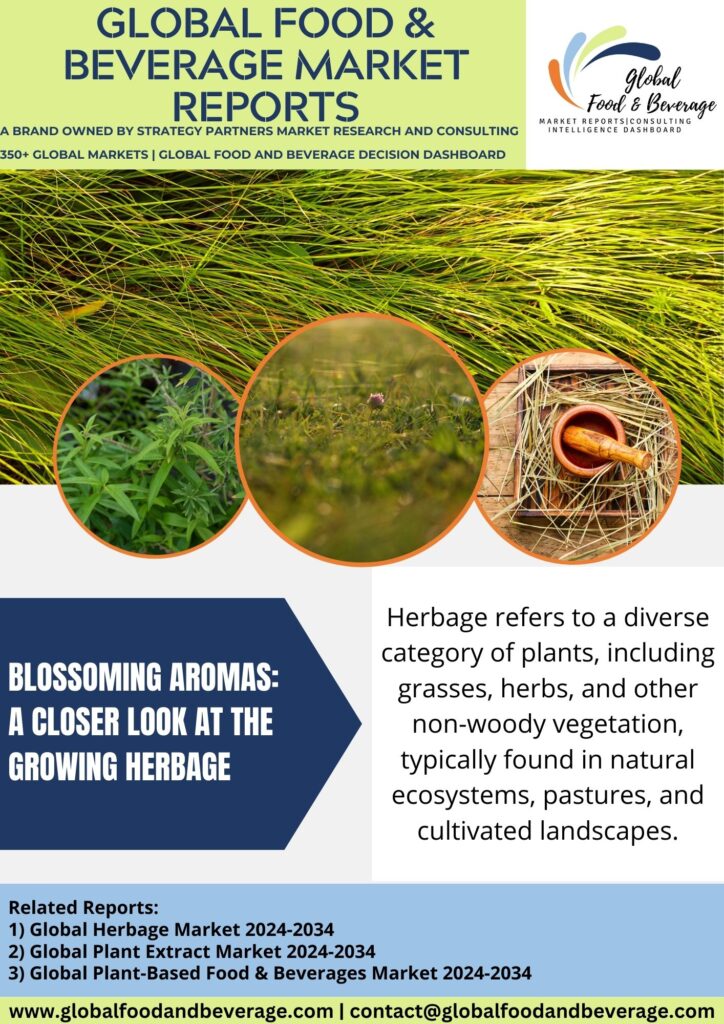Blossoming Aromas: A Closer Look at the Growing Herbage Market
Herbage refers to the collective vegetation, typically comprised of herbs, grasses, and other non-woody plants, that covers a particular area of land. This term is often associated with pastures, meadows, and open fields where diverse plant life thrives. Herbage market plays a crucial role in various ecosystems, providing essential functions such as soil stabilization, nutrient cycling, and habitat for numerous species.

In natural settings, herbage contributes to biodiversity by supporting a variety of plant species, each adapted to its specific environmental conditions. This diverse array of vegetation, from wildflowers to grasses, creates a visually appealing landscape and fosters ecological balance. It also serves as a vital food source for many herbivores, including insects, birds, and mammals.
In agricultural contexts, herbage takes on added significance as it forms the basis of forage for livestock. Grazing animals, such as cows and sheep, depend on herbage for nutrition, and farmers carefully manage pastures to ensure sustainable forage production. The health and productivity of herbage are crucial factors in maintaining the well-being of both natural ecosystems and agricultural landscapes.
Herbage is subject to various factors that influence its composition and abundance. Climate, soil conditions, and human activities all play roles in shaping the characteristics of herbage in a given area. Sustainable land management practices aim to preserve and enhance herbage, recognizing its importance for both environmental health and agricultural productivity.
Beyond its ecological and agricultural significance, herbage holds cultural and aesthetic value. Meadows adorned with colorful wildflowers or expanses of green grass contribute to the visual beauty of landscapes and have inspired art, literature, and cultural practices throughout history. Recognizing the importance of herbage in multiple dimensions—from ecological resilience to cultural appreciation—underscores the need for responsible land stewardship to ensure the continued health and diversity of these plant communities.
ADVANCEMENTS
Herbage, encompassing a variety of herbaceous plants with culinary, medicinal, or aromatic uses, reflect a broader trend toward sustainable agriculture, diverse flavor profiles, and holistic well-being. One significant breakthrough is the adoption of innovative cultivation practices for herbs. Vertical farming, hydroponics, and controlled environment agriculture contribute to year-round production, reducing environmental impact and ensuring a consistent supply of fresh herbs.
Advancements in organic and regenerative farming practices for herbage emphasize soil health, biodiversity, and minimal chemical inputs. The cultivation of herbs in agroecological systems supports environmentally friendly agriculture while meeting the demand for clean and sustainably sourced herbs.
The exploration and popularization of lesser-known or exotic herbs contribute to diversifying flavor options in culinary experiences. Chefs, home cooks, and food manufacturers are incorporating herbs like shiso, epazote, or culantro to bring unique and authentic flavors to dishes, reflecting a growing appreciation for global cuisines.
Research on the health benefits of herbs and their bioactive compounds is driving innovation in herbal supplements, teas, and functional foods. Advances in extraction and formulation technologies help preserve the potency of these bioactive compounds, offering consumers convenient and effective ways to incorporate herbs into their wellness routines.
Herbs are increasingly being used as ingredients in sustainable packaging solutions, aligning with consumer preferences for eco-friendly and biodegradable materials. The integration of herbs into packaging not only serves functional purposes, such as natural preservatives, but also contributes to the overall sustainability of the product life cycle.
CHALLENGES
Herbage, referring to a mix of herbaceous plants or grasses, encounters challenges across cultivation, utilization, and market dynamics. One significant challenge is sustainable cultivation practices. Intensive agricultural methods can lead to soil degradation, loss of biodiversity, and environmental issues. Implementing sustainable farming practices, such as agroecological approaches and regenerative agriculture, is essential for maintaining the health of herbage ecosystems.
Diverse plant compositions in herbage present challenges in terms of optimizing yields and nutritional content. Selecting the right combination of herbaceous plants, managing their growth, and ensuring a balance of nutrients are ongoing challenges for farmers to meet the needs of various end-users, including livestock feed, culinary applications, or medicinal purposes.
Market dynamics and consumer preferences add complexity to the herbage industry. Successfully differentiating products, addressing diverse uses, and staying competitive in a dynamic market demand innovation in cultivation methods, product development, and marketing strategies.
Climate change poses a significant challenge to herbage cultivation. Altered weather patterns, increased temperatures, and extreme events can impact herbage productivity and quality. Adapting cultivation practices to changing climatic conditions and promoting resilient plant varieties are crucial for mitigating the impact of climate change.
Regulatory compliance, especially concerning environmental standards and sustainable farming practices, is a growing challenge in the herbage industry. Adhering to regulations related to land use, pesticide use, and water management demands continuous diligence to ensure transparency and compliance.
Consumer education is essential for promoting the various uses and benefits of herbage. Communicating the nutritional, environmental, and economic advantages of herbage products is crucial for building consumer awareness and fostering informed choices.
CONCLUSION
Herbage emerges as a botanical tapestry weaving through culinary, medicinal, and aromatic realms. Beyond mere plants, herbage encompasses a diverse spectrum of herbs, grasses, and botanical wonders that enhance our lives. From culinary creations to holistic healing, its aromatic allure and health benefits are timeless. As consumers seek natural remedies and authentic flavors, herbage becomes an emblem of both tradition and innovation. The future promises continued exploration of diverse herbage applications, from culinary delights to wellness formulations, offering a fragrant journey where the multifaceted beauty and utility of herbs continue to flourish in kitchens, gardens, and apothecaries worldwide.
